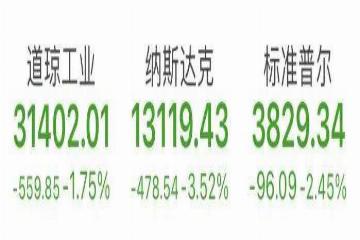U.S. Bonds Collapse, Stocks Plunge
Advertisements
The recent turmoil in the U.Sstock market has ignited widespread concern among investors, reminiscent of a profound crash felt back during the 2008 financial crisisOn February 25th, the pivotal indexes endured staggering losses, with the Dow Jones Industrial Average plummeting nearly 560 points, concluding at 31,402.01—equating to a 1.75% dropThe Nasdaq Composite, particularly hit, experienced a dramatic plunge of 3.52%, marking its most significant decline since October of the previous year, while the S&P 500 fell by 2.45%, showcasing the largest single-day drop observed since late January 2021.
This stark decline was mirrored across major technology stocks that had previously captured the market's confidenceIcons like Apple and Amazon saw their shares tumble by 3.48% and 3.24%, respectivelyAlphabet, the parent company of Google, followed suit with a 3.26% lossFacebook and Microsoft weren’t spared either, falling by 3.64% and 2.37%. Notably, high-profile Chinese stocks did not escape the carnage; Alibaba dropped 4.06%, with Sohu and JD.com also taking tremendous hits
Advertisements
However, in a rare instance, Bilibili managed to soar by 3.70% amidst the broader sell-off.
One of the prevailing reasons behind this market downturn is credited to the soaring U.STreasury yieldsOn the same date, the yield on the benchmark 10-year U.STreasury surged at one point to 1.6%, before retracing slightly, still remaining around 1.52%. This level of yield hasn't been seen since February 2020, emphasizing the shift in market sentimentBut why would a rise in bond yields correlate with a plummeting stock market? Investors tend to anticipate that a booming economy comes with heightened inflationary pressuresConsequently, as such conditions materialize, bond yields naturally increase as investors shift towards safer securities, reflecting optimism concerning the economy's recovery from the COVID-19 crisis—a paradoxical indication that could signify a healthy economic backdrop.
An essential query arises here: Isn’t the stock market a barometer of economic vitality? Shouldn’t the improved economic outlook, therefore, buoy the stock market even further? However, the current atmosphere reveals a temporary reversal in investor sentiment, primarily rooted in worries about inflation
Advertisements
There is speculation that the Federal Reserve may feel pressured to adjust its policy earlier than anticipated—either tapering its bond-buying program or embarking on interest rate hikesSuch changes in monetary policy imply a tightening of liquidity, which could negatively impact the buoyancy of stock indices.
Historical patterns suggest that an influx of liquidity typically bolsters market performanceThe unprecedented stock market surge in 2020 has been attributed to aggressive monetary policiesDespite the economic devastation wrought by the pandemic, the U.Sgovernment and the Federal Reserve initiated a massive $3.2 trillion stimulus plan, flooding the economy with cash and propelling the stock market to new heights, highlighted by a robust recovery punctuated by remarkable gains.
The reflection of economic healing is accentuated by reports from the U.SDepartment of Labor which indicated an unexpected drop in unemployment claims—73,000 initial claims were recorded against an expected 825,000, and the downturn in continuing claims marked the sixth consecutive week of improvement
Advertisements
Hence, with increased expectations for economic recovery, investors anticipate the Federal Reserve will scale back its expansive monetary policy, further contributing to the decline in stock prices.
This debacle overwhelmingly impacted sectors heavily reliant on cheap borrowing for growth—primary among them, tech and internet economy stocksWith capital becoming scarcer, the availability of loans inevitably diminishes, leading to a downward revision in growth expectationsCoupled with the fact that tech stocks had been on a robust streak throughout the past two years, record valuations have made these stocks an attractive target for profit-takingAdditionally, investors are gradually pivoting their attention toward sectors more likely to thrive in a recovering economy, like energy, demonstrated by a significant 6.8% uptick this week in energy stocks, now recognized as the primary beneficiaries.
As the perspective shifts favorably toward an improved economic outlook, the U.S
- Focus on Financial Service Details
- Unveiling Quantum Stock Volatility
- Bank of Korea Maintains Interest Rate at 3%
- Currency or Stocks: A Policy Dilemma
- Digitalization Boosts Sino-Arab Energy Ties
dollar is once again beginning to assert strength against previous trends of weaknessRecently, in New York's late trading, the dollar index rose by 0.19% to settle at 90.2149, asserting a recovery following a prior drop below the 90 thresholdThe fluctuating landscape also reveals an overall downturn for most non-dollar currencies, showcasing the shifting narrative.
Within China's market, this situation manifested through a depreciation of the yuanThe offshore yuan against the dollar weakened by 419 basis points, reflecting broader external influencesWith the dollar gaining strength, the gold market, typically seen as a safe-haven asset, has been adversely affectedThe uptick in U.STreasury yields culminated in a notable drop in gold prices by over 2%, reaching its lowest levels in over a week.
For investors on the A-shares market, understanding how to navigate this volatility is pivotal

It is imperative to realize that these market changes stem from momentary sentiment variations and will not fundamentally alter the robust nature of the marketTypically, these fluctuations exert the most pronounced impact on opening trading sessions, particularly the early segmentsObserving the bigger picture, the long-term prosperity hinges on the economy's rebound from the pandemic; any sustainable growth trajectory will invariably favor the stock market.
Despite the recent downturn, many individual stocks within the A-share market have maintained resilience, with numerous firms experiencing gainsFor instance, the shares of Moutai have fluctuated, notably from a peak of 2627 to around 2100. Some previously high-flying stocks are already signaling a decline in their collective momentumAs a prudent strategy, everyday investors should refrain from desperately seeking out bargain opportunities in those high-profile stocks, instead focusing on companies demonstrating continual performance enhancements
Leave a Reply
Your email address will not be published. Required fields are marked *